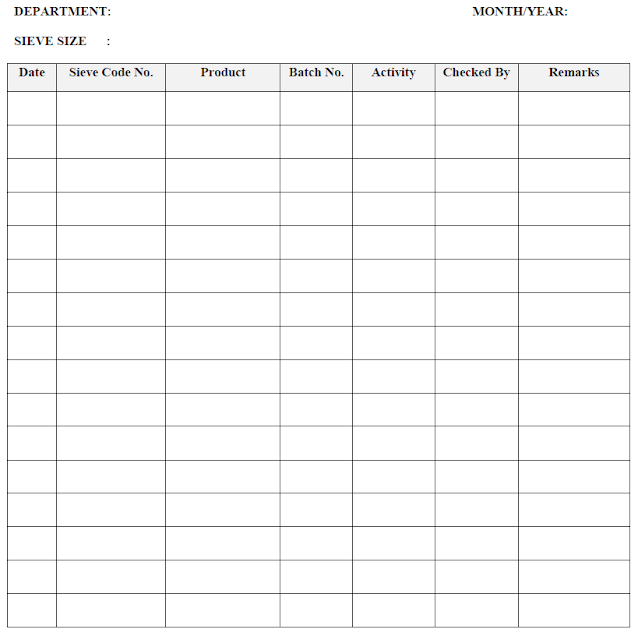In this post Standard Operating Procedure Cleaning and Operation of Vibratory Sifter (12 Inch) in Pharmaceuticals is describe.
1.0 OBJECTIVE:
To lay down a procedure for Cleaning and Operation of Vibratory Sifter (12 Inch).
2.0 SCOPE:
This SOP applies to the Cleaning and Operation of Vibratory Sifter (12 Inch) in Production Area.
3.0 RESPONSIBILITY:
Technical Associate : Cleaning and Operation
Officer and Executive : Supervision
Head Production : SOP compliance
IPQA Person : Line Clearance
4.0 DEFINITION (S):
NA.
5.0 PROCEDURE:
5.1 “TYPE A” CLEANING: Change over from one batch to next batch of the same product, same potency and of similar product with ascending potency
5.1.1 Affix “TO BE CLEANED” label to the machine.
5.1.2 Enter the cleaning starting time in equipment usage log sheet as per SOP.
5.1.3 Ensure that the main power supply is switched off.
5.1.4 Remove the adhered material on the sifter by using vacuum cleaner or by lint free duster.
5.1.5 Dismantle the lid, feed hopper, sieve, S.S. frame, discharge chute and the gaskets.
5.1.6 Clean the S.S. feed hopper, S.S. frame, holding the sieve in place and S.S. wire mesh sieve with lint free cloth.
5.1.7 Clean the outlet chute, rubber gasket, feed hopper tighten clamp by using lint free cloth.
5.1.8 Replace the “TO BE CLEANED” status label with “CLEANED” status label with date and signature of the Production Officer/ QA Officer.
5.1.9 Record the cleaning activity in equipment usage log sheet as per SOP.
5.2 “TYPE B” CLEANING: This is a cleaning procedure for Change over of product with different actives/ colour/ descending potency/ If the same product processed for more than a week or after maintenance of contact parts.
5.2.1 Follow the procedure from step 5.1.1 to 5.1.6
5.2.2 Put all the dismantled parts in a virgin poly bag affixed with “TO BE CLEANED” label and transfer the poly bag to respective cleaning area.
5.2.3 Clean the dismantled parts of the sifter using sufficient quantity of purified water with nylon brush to remove the adhered material.
5.2.4 Clean the cleaned parts with 2% sodium lauryl sulfate (For 1 liter 2% Sodium Lauryl Sulphate, take 20 g Sodium Lauryl Sulphate and dissolve in 1 liter of purified water) before final rinsing of equipment/parts in case of previous product API is Efavirenz.
5.2.5 Clean all the dismantled parts with 50-60 liters of purified water.
5.2.6 Clean the sieve by using purified water with a nylon brush.
5.2.7 Apply a jet of purified water so as to ensure the complete removal of the previous product.
5.2.8 Dry the sieve by using compressed air.
5.2.9 Wipe the body of the sifter with wet duster soaked in purified water.
5.2.10 Dry all the dismantled parts with a dry lint free duster.
5.2.11 Wipe all the dismantled parts of the sifter and its body with 70% v/v IPA solution and transfer all the cleaned parts to the respective cubicle in virgin poly bag with “CLEANED” label.
5.2.12 Record the cleaning activity in Annexure-II.
5.2.13 Assemble the sifter without the sieve. Store the sieve by covering with a polythene bag and label as “CLEANED” status label with date and signature of the production/QA officer.
5.2.14 Transfer the sieve to the sieve storage area and record the utilization and cleaning details in Annexure –I.
5.2.15 Affix label on sifter as “CLEANED” with date and signature of the Production Officer, as per SOP.
5.2.16 Record the cleaning activity of sifter in equipment usage log sheet as per SOP.
5.2.17 If the sifter and the sieve are idle for 72 hours or more, Wipe all the parts of the sifter with 70% v/v IPA solution before use. And should be a counter sign on previous “CLEANED” label by production & QA officer with date as per SOP.
5.2.18 Record the 70 % v/v IPA cleaning time of equipment in equipment usage logbook as per SOP.
5.2.19 Record the sifter sieve utilization and cleaning as per Annexure –I
5.3 Frequency:
5.3.1 Type ‘A’ cleaning is applicable after completion of every batch of same product, same potency and of similar product with ascending potency. If same product is processed for more than seven then follow the procedure of Type – B cleaning.
5.3.2 Type ‘B’ cleaning is applicable in case of change over of product with different actives / colour / descending potency or after maintenance of contact parts or same product is run for more than seven days cleaning Type - B done after completion of batch.
5.3.3 Cleaning is applicable in case of at the end of working day, de-dusting of machine with vacuum cleaner or dry by lint free cloth.



.webp)





%20Web%20of%20pharma%20.webp)


%20webofpharma.JPG)
